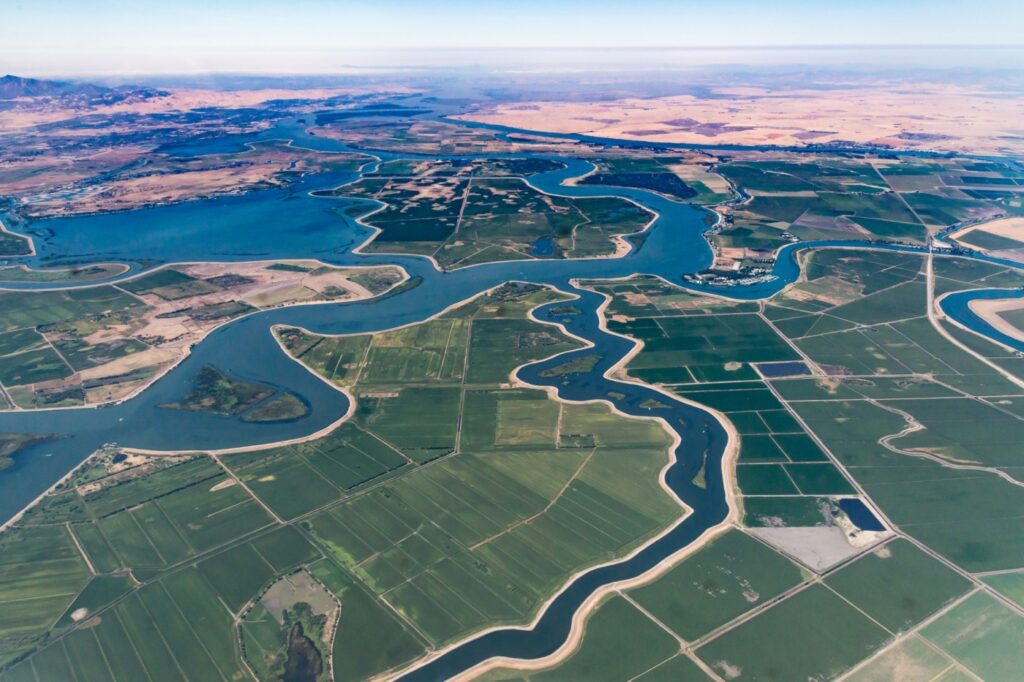
Conditions in the Sacramento-San Joaquin Delta and its watershed are changing as droughts become warmer and more intense. But as our new study highlights, California is not doing a good job of tracking these changes. That’s making it even tougher to manage the water that is available for the benefit of the state’s communities, economy and environment.
This critical watershed supplies water to more than 30 million people and more than 6 million acres of farmland. It also supports commercial and recreational fisheries and provides vital habitat for many endangered native fish and other aquatic species.
But temperatures are rising, as is evaporative demand, or the “thirst of the atmosphere.” This is drying out vegetation and soils, shrinking the snowpack — a key part of seasonal water storage — and reducing available runoff. Upstream use of river water also appears to be rising — possibly a result of thirstier soils and crops — further reducing the amount that reaches the delta.
The drying of the delta watershed has consequences for water supply and the environment.
For example, to keep the delta fresh enough for water users, a significant (and growing) portion of runoff must flow into San Francisco Bay. This outflow also protects habitat for endangered fish. To meet outflow needs during droughts, we’re leaning more heavily than ever intended on upstream reservoirs and, in turn, making it even harder for these reservoirs to meet other needs, including protecting cold-water salmon habitat and supplying communities elsewhere in the state.
Our study identifies four imperatives for adapting delta water management to these changes. We need to:
Get better at tracking water use. In 2021, upstream and in-delta uses accounted for a staggering 100% of the runoff in the basin, leaving depleted reservoirs to meet all other needs. Yet the state lacks timely, precise information on these uses — information that’s essential to managing the water rights system and curtailing these users when supplies are too tight.
Establish routine practices for managing severe droughts, rather than relying on emergency declarations. To improve response capacity, it’s critical to adapt forecasting to better capture the warmer, drier conditions of today’s droughts (an effort now underway). We also need to anticipate alternative actions as the season unfolds and improve the ability to curtail diversions. To better manage salinity, we also should consider new infrastructure in the delta — something similar to the temporary barrier used to impede seawater during this drought and the last one. (As less freshwater flows down the river, seawater encroaches farther into the delta, raising the salinity.)
Simplify, unify and modernize environmental regulations. Regulations to protect species and their habitat are essential in this watershed, but these regulations have become increasingly complex, overlapping and, occasionally, contradictory. Ongoing efforts to revise the water quality control plan for the watershed, and to update federal and state endangered-species protections, create an opportunity to make regulations more coordinated and effective. Building in flexibility can help both environmental water managers and water users respond to rapidly changing hydrologic conditions.
Related Articles
Keep the Quad flexible
Legislature’s supermajorities spawn super sneakiness
Newsom’s aid plan triggers inflation spiral
One-party-rule has made California unaffordable for hardworking families
New York’s governor wants to ‘silence’ constitutionally protected speech
Get better at storing water in wet years. Although droughts are getting more intense, wet years still occur — and they result in outflow well beyond what’s needed for salinity and species protections. Storing more water has to be done with care for the environment and other water users. It is possible, however, to do a better job of storing water during wet years — both above and below ground — without doing harm. This is a key climate change adaptation strategy, and it will require identifying cost-effective investment options and adapting operations and regulatory approaches.
California needs to come to grips with the fact that conditions are changing in its most important watershed. Modernizing our drought and wet-year management tools is the best way to ensure that not every dry period becomes an emergency.
Ellen Hanak is an economist and director of the Public Policy Institute of California’s Water Policy Center. Greg Gartrell is an independent consulting engineer and an adjunct fellow at the Public Policy Institute of California’s Water Policy Center.
